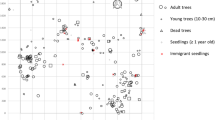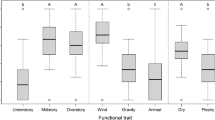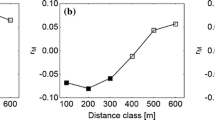Abstract
Seed dispersal is an important factor influencing the genetic structure of forest tree populations. Knowledge about the seed shadow is important to assess the ability of tree species to colonize new and disturbed habitats or to respond to environmental change by migrating to more suitable habitats. In a seed trap experiment, we investigated local seed dispersal distances of silver fir seeds (Abies alba Mill.) by explicitly identifying mother trees. For this purpose, we matched microsatellite genotypes of maternal tissues of seeds with the genotypes of adult trees in the studied stand. Furthermore, we analysed the effect of morphological traits on dispersal distance, and we assessed the number of contributing mother trees and compared the seed density of the closed forest-stand with the adjacent blowdown. Based on 674 seeds collected in a grid of 37 seed traps, a significant decline in seed density was observed from within the forest to the forest blowdown area >40 m from the forest edge. A median dispersal distance of 31 m was determined for filled seeds based on direct assignment of seeds to their mother trees. This was higher than that determined in the previous studies using different methods. Dispersal distance was negatively correlated to seed-weight, but this was partially compensated for by the length of seed wings. A very large number of unassigned maternal genotypes (435) suggested that dispersal distance might have been underestimated. Lessons for future studies were: to perform a full genotypic inventory of adult trees in a defined perimeter, to increase the number of microsatellite markers and to study several sites over a period of several years.




Similar content being viewed by others
References
Bacles CFE, Lowe AJ, Ennos RA (2006) Effective seed dispersal across a fragmented landscape. Science 311:628
Chauchard S, Beilhe F, Denis N, Carcaillet C (2010) An increase in the upper tree-limit of silver fir (Abies alba Mill.) in the Alps since the mid-20th century: a land-use change phenomenon. For Ecol Manage 259:1406–1415
Crawley MJ (2007) The R Book. Wiley, Chichester
Cremer E, Liepelt S, Sebastiani F, Buonamici A, Michalczyk I, Ziegenhagen B, Vendramin G (2006) Identification and characterization of nuclear microsatellite loci in Abies alba Mill. Mol Ecol Notes 6:374–376
Dumolin S, Demesure B, Petit RJ (1995) Inheritance of chloroplast and mitochondrial genomes in pedunculate oak investigated with an efficient PCR method. Theor Appl Genet 91:1253–1256
Ellenberg H, Leuschner C (2010) Vegetation Mitteleuropas mit den Alpen: in ökologischer, dynamischer und historischer Sicht. UTB, Stuttgart
Gagneux P, Boesch C, Woodruff DS (1997) Microsatellite scoring errors associated with noninvasive genotyping based on nuclear DNA amplified from shed hair. Mol Ecol 6:861–868
Gastineau G, Soden BJ (2009) Model projected changes of extreme wind events in response to global warming. Geophys Res Lett 36:L10810
Godoy JA, Jordano P (2001) Seed dispersal by animals: exact identification of source trees with endocarp DNA microsatellites. Mol Ecol 10:2275–2283
Grivet D, Smouse PE, Sork VL (2005) A novel approach to an old problem: tracking dispersed seeds. Mol Ecol 14:3585–3595
Hamrick JL, Godt MJW (1996) Effects of Life history traits on genetic diversity in plant species: philosophical transactions of the Royal Society of London. Philos Trans R Soc Lond Ser B 351:1291–1298
Hasenkamp N, Ziegenhagen B, Mengel C, Schulze L, Schmitt H-P, Liepelt S (2011) Towards a DNA marker assisted seed source identification: a pilot study in European beech (Fagus sylvatica L.). Eur J For Res 130:513–519
Hausser K (1956) Ertragstafeln für die Weißtanne, mäßige Durchforstung. Hilfstafeln für die Forsteinrichtung. Bayerisches Staatsministerium für Ernährung, Landwirtschaft und Forsten
Houle G, Payette S (1991) Seed Dynamics of Abies balsamea and Acer saccharum in a Deciduous Forest of Northeastern North America. Am J Bot 78:895–905
Kalinowski ST, Taper ML, Marshall TC (2007) Revising how the computer program cervus accommodates genotyping error increases success in paternity assignment. Mol Ecol 16:1099–1106
Kohlermann L (1950) Untersuchungen über die Verbreitung der Samen und Früchte mitteleuropäischer Bäume durch den Wind. Dissertation, University of Munich
Kormut’ák A, Lindgren D (1996) Mating system and empty seeds in silver fir (Abies alba Mill.). For Genet 3:231–235
Kraft G (1884) Beiträge zur Lehre von den Durchforstungen, Schlagstellungen und Lichtungshieben. Klindworth’s Verlag, Hannover
Leckebusch GC, Ulbrich U (2004) On the relationship between cyclones and extreme windstorm events over Europe under climate change. Global Planet Change 44:181–193
Liu TS (1971) A monograph of the genus Abies. Department of Forestry, National Taiwan University, Taipei
Marshall TC, Slate J, Kruuk LEB, Pemberton JM (1998) Statistical confidence for likelihood-based paternity inference in natural populations. Mol Ecol 7:639–655
Motta R, Brang P, Carcaillet C (2009) Introductory remarks: natural hazards and disturbances in mountain forests. Ecoscience 16:4–5
Nathan R, Muller-Landau HC (2000) Spatial patterns of seed dispersal, their determinants and consequences for recruitment. Trends Ecol Evol 15:278–285
Oddou-Muratorio S, Petit RJ, Guerroue BL, Guesnet D, Demesure B (2001) Pollen-versus seed-mediated gene flow in a scattered forest tree species. Evolution 55:1123–1135
Paetkau D, Waits LP, Clarkson PL, Craighead L, Vyse E, Ward R, Strobeck C (1998) Variation in Genetic Diversity across the Range of North American Brown Bears. Conserv Biol 12:418–429
Paluch JG (2011) Ground seed density patterns under conditions of strongly overlapping seed shadows in Abies alba Mill. stands. Eur J For Res. doi: 10.1007/s10342-011-0486-4
Peakall R, Smouse PE (2006) Genalex 6: genetic analysis in Excel: population genetic software for teaching and research. Mol Ecol Notes 6:288–295
Rammig A, Fahse L, Bugmann H, Bebi P (2006) Forest regeneration after disturbance: a modelling study for the Swiss Alps. For Ecol Manage 222:123–136
Raymond M, Rousset F (1995a) GENEPOP (Version 1.2): population genetics software for exact tests and ecumenicism. J Hered 86:248–249
Raymond M, Rousset F (1995b) An exact test for population differentiation. Evolution 49:1280–1283
R-Development-Core-Team (2011) R: a language and environment for statistical computing. R Foundation for Statistical Computing, Vienna
Rohmeder E (1972) Das Saatgut in der Forstwirtschaft. Paul Parey, Hamburg
Rousset F (2008) Genepop’007: a complete re-implementation of the genepop software for Windows and Linux. Mol Ecol Res 8:103–106
Sagnard F, Pichot C, Dreyfus P, Jordano P, Fady B (2007) Modelling seed dispersal to predict seedling recruitment: Recolonization dynamics in a plantation forest. Ecol Model 203:464–474
Sagnard F, Oddou-Muratorio S, Pichot C, Vendramin GG, Fady B (2011) Effects of seed dispersal, adult tree and seedling density on the spatial genetic structure of regeneration at fine temporal and spatial scales. Tree Genet Genomes 7:37–48
Saltré F, Chuine I, Brewer S, Gaucherel C (2009) A phenomenological model without dispersal kernel to model species migration. Ecol Model 220:3546–3554
Snäll T, O’Hara RB, Arjas E (2007) A mathematical and statistical framework for modelling dispersal. Oikos 116:1037–1050
Strassburger E, Noll F, Schimper AFW (1998) Lehrbuch der Botanik. In: P Sitte, H Ziegler, F Ehrendorfer, Bresinsky (Eds) Gustav Fischer, Stuttgart, Jena, Lübeck and Ulm
Stueve KM, Cerney DL, Rochefort RM, Kurth LL (2009) Post-fire tree establishment patterns at the alpine treeline ecotone: Mount Rainier National Park, Washington, USA. Veg Sci 20:107–120
Taberlet P, Luikart G (1999) Non-invasive genetic sampling and individual identification. Biol J Linn Soc 68:41–55
Tracz M, Barzdajn W (2007) The morphological traits of cones and seeds of Abies alba in the Middle Sudeten. Dendrobiology 58:59–65
Willson MF (1993) Dispersal mode, seed shadows, and colonization patterns. Plant Ecol 107:261–280
Young JA, Young CG (1992) Seeds of woody plants in North America. Discorides Press, Portland
Ziegenhagen B, Liepelt S, Kuhlenkamp V, Fladung M (2003) Molecular identification of individual oak and fir trees from maternal tissues of their fruits or seeds. Trees-Struct Funct 17:345–350
Acknowledgments
We thank G. Bauer for administrative support, A. Ernst and Ch. Genser for support in sampling and mapping of the adult trees, the staff of the forest office Freudenstadt (esp. G. Groß and M. Morllock and his apprentices) for practical support during the work in the forests. This project was funded by the DFG (Deutsche Forschungsgemeinschaft, Bonn, Project ZI 698/5) and supported by the EU Network of Excellence EVOLTREE.
Author information
Authors and Affiliations
Corresponding author
Additional information
Communicated by J. Carlson.
In memory of Günther Groß.
Rights and permissions
About this article
Cite this article
Cremer, E., Ziegenhagen, B., Schulerowitz, K. et al. Local seed dispersal in European silver fir (Abies alba Mill.): lessons learned from a seed trap experiment. Trees 26, 987–996 (2012). https://doi.org/10.1007/s00468-012-0676-9
Received:
Revised:
Accepted:
Published:
Issue Date:
DOI: https://doi.org/10.1007/s00468-012-0676-9




